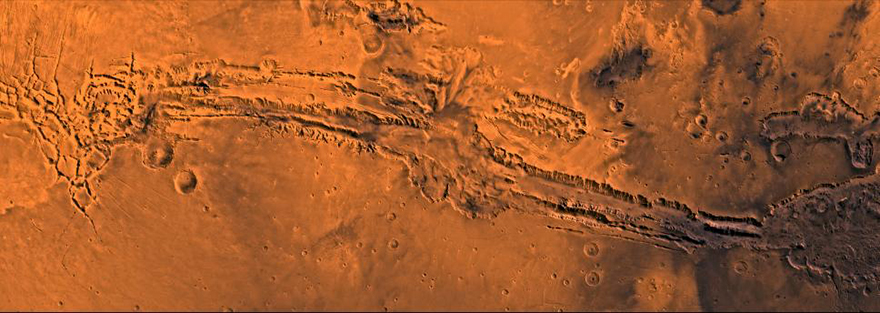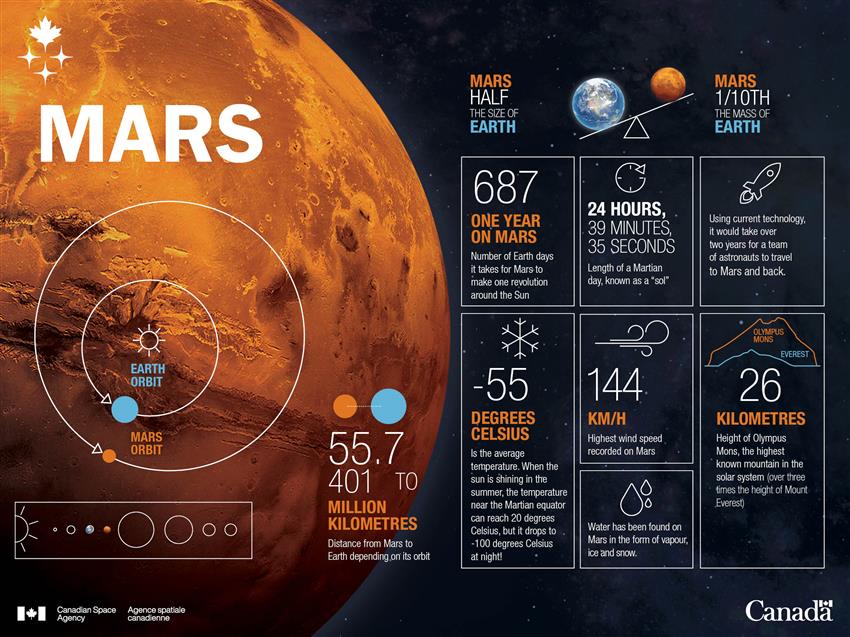Mars
About Mars
| Type | Rocky planet |
|---|---|
| Size (diameter) | 6791 km, or about half the size of Earth |
| Mass | 6.417 × 1023 kg, or about 10% the mass of Earth |
| Length of a year (orbital period) | 687 days |
| Number of moons | Two: Phobos and Deimos |
| Average distance from the Sun | 227,939,200 km |
| Temperature | Between -140 and 30 degrees Celsius |

Credit: NASA
Formation
Mars is the fourth planet from the Sun in our solar system. Scientists believe that all of the planets were created just over 4.5 billion years ago. The solar system began as a large cloud of gas, dust, and ice, which collapsed into a spinning disc. The Sun was formed at its centre and particles began sticking together along rings in the disc – leading to the formation of the planets.
Orbit and rotation
A year on Mars – the time it takes for the planet to orbit the Sun – is nearly twice as long as a year on Earth. However, the planets rotate at a similar frequency: a day on Mars (known as a sol) lasts about 24 hours and 40 minutes in Earth time.
Mars is tilted by about 25 degrees, which means that the red planet has four seasons, too – each twice as long as Earth's!
Surface
Mars is known as the "red planet" due to its reddish hue caused by oxidized iron (or rust) on the planet's surface.
The tallest mountain in the entire solar system, Olympus Mons, is on Mars. This extinct volcano is nearly 22 km tall – roughly two and a half times the height of Mount Everest.
Valles Marineris is a massive canyon system that stretches over 3,000 km across Mars's surface – about the distance between Montreal and Calgary! Plunging about 8 km deep, and often referred to as "the Grand Canyon of Mars," Valles Marineris makes the red planet home to the largest known canyon in the solar system.

This composite image captured by the Viking Orbiters 1 and 2 shows the intricate canyon network just below the planet's equator. (Credit: NASA/JPL-Caltech)
Is there water on Mars?
The search for water on Mars dates back to the s. In , Italian astronomer Giovanni Schiaparelli observed a network of lines on the surface of Mars, which he called "canali" in Italian. The mistranslation as "canals" in English fuelled speculation about the possibility of both flowing water and intelligent life on Mars.
Since then, planetary flyby missions, improved imaging techniques, and data collected by orbiters, landers, and rovers have given scientists a better understanding of the Martian landscape.
Water ice was found on the north and south poles of Mars, much of it underneath glaciers of frozen carbon dioxide. However, a small amount of water exists in Mars's thin atmosphere: Canada's meteorological station on the Phoenix mission was the first to detect snow, which vaporized before it hit the ground.
A rich past
Since liquid water cannot currently exist on the surface due to Mars's low atmospheric pressure, traces of ancient riverbeds and lakes imply that a vast quantity of liquid water may once have existed in the presence of a denser atmosphere.
Mars also used to have a global magnetic field, but scientists believe the planet lost it about 4 billion years ago. Some evidence suggests that ancient Mars may have been similar to Earth, and may have harboured the right conditions for life.

A colour panorama taken of the surface of Mars by NASA's Mars Pathfinder mission in . (Credit: NASA)
The Babylonians divided the week into seven days, each one in honour of a celestial body within our solar system:
- Sunday was named for the Sun
- Monday, the Moon
- Tuesday, Mars (more easily recognizable in the French word "mardi")
- Wednesday, Mercury
- Thursday, Jupiter
- Friday, Venus
- and Saturday, Saturn
Because of its red appearance in the night sky, many ancient civilizations associated Mars with war. In English, the word "Tuesday" is derived from the Norse god Tyr, who is the equivalent of Mars, the Roman god of war.
Martian exploration
Many missions have been sent to explore Mars, but only 50% have been successful due to the significant challenges caused by the Martian atmosphere. Landing safely on Mars requires a creative combination of heat-shielding, rocket-powered descent, and parachutes.
NASA's Viking 1 and Viking 2 spacecraft were the first to successfully land and explore the surface of Mars in . These spacecraft were designed to search for signs of life on Mars.
One of the greatest successes in planetary exploration was the Opportunity rover, which landed on Mars in . It had a planned mission lifetime of only 90 days but ended up exploring the Martian surface for over 14 years. The rover travelled a record-breaking 45 km of the Martian surface and helped scientists better understand Mars's geology and climate. Opportunity's twin, the Spirit rover, also collected data for over 20 times longer than its planned mission.
NASA's Curiosity rover, which is currently exploring Mars, has travelled over 20 km on the red planet's surface. Curiosity analyzes Martian soil with a Canadian-made geology instrument called APXS, led by Dr. Ralf Gellert (University of Guelph). To date, APXS has sent over 1500 scientific results back to Earth!
The Canadian Space Agency (CSA) also funds Canadian scientists who are participating in other international Mars missions:
- Dr. Livio Tornabene (Western University) and Dr. Ed Cloutis (University of Winnipeg) are involved in the European Space Agency's ExoMars Trace Gas Orbiter, a satellite designed to study Martian atmosphere. The satellite also carries a Canadian-built communication antenna subsystem.
- Dr. Catherine Johnson and Anna Mittelholz from the University of British Columbia are part of NASA's InSight mission, which takes a closer look at the structure and composition of Mars's inner layers.
- Dr. Chris Herd from the University of Alberta is a participating scientist on the Mars mission, which includes a rover designed to collect and store samples for possible return to Earth.
The future of Mars exploration will not only involve robots, but humans as well. With increased crew autonomy, the long-duration missions needed to reach the red planet will soon become reality.

Text version - Planet Mars in numbers - Infographic
Infographic comparing Planet Mars with Planet Earth. (Credit: CSA)
Going to Mars: a complex endeavour
Sending crewed missions to the red planet is a long-term goal of international space agencies. However, a number of important factors must be taken into account when planning a mission:
- Launch windows: Because of the massive amount of energy needed to launch an interplanetary journey, space engineers must carefully calculate the most efficient path. The orbits of Earth and Mars create launch windows every 26 months.
- A tricky place to land: Entering the Martian atmosphere – and slowing down a descent module at the right speed and angle to ensure a successful landing – is no easy feat.
- Communications delay: Depending on the distance between Earth and Mars, commands sent to the red planet take almost 20 minutes to arrive, and another 20 minutes for a response to travel back to Earth.
- And other challenges: With current technology, a journey to Mars would take at least two years. A crew travelling to the red planet would face unprecedented isolation and high levels of radiation. They would need to be highly independent from Earth and would have to grow their own food to stay healthy in space.
Mars hoax: Mars will not appear to be the same size as the Moon
For over 15 years, a persistent falsehood has resurfaced on the Internet almost every summer. The rumour alleges that on the night of August 27, Mars will appear to be as large as the full Moon, a once-in-a-lifetime event that will not happen again until the year 2287. This hoax may have arisen in part because Mars appeared to be larger than usual on , when it made its closest approach to Earth in 60,000 years. However, because of the great distance between Earth and Mars, the red planet cannot possibly appear to be as big as the Moon, even when it is magnified by a telescope.
